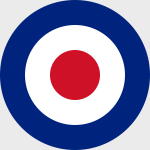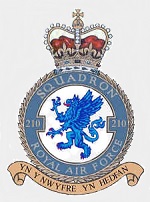Corgi AA36111 RAF Consolidated Catalina Mk.IVA Flying Boat - JV928 'Y' Flight Officer Alexander Cruickshank, VC 210 Squadron, July 1944 [100 Years of the RAF] (1:72 Scale)
"Never in the field of human conflict was so much owed by so many to so few."
- British Prime Minister Winston Churchill, commenting on the British airmen in the Battle of Britain
 The PBY Catalina was the US Navy designation for an American and Canadian-built flying boat of the 1930s and 1940s. PB stands for Patrol Bomber, with Y being Consolidated's manufacturer identification. It could be equipped with depth charges, bombs, torpedoes, and .50 caliber machine guns and was one of the most widely used multi-role aircraft of World War II. Catalinas served with every branch of the US military and in the air forces and navies of many other nations.
The PBY Catalina was the US Navy designation for an American and Canadian-built flying boat of the 1930s and 1940s. PB stands for Patrol Bomber, with Y being Consolidated's manufacturer identification. It could be equipped with depth charges, bombs, torpedoes, and .50 caliber machine guns and was one of the most widely used multi-role aircraft of World War II. Catalinas served with every branch of the US military and in the air forces and navies of many other nations.
In World War II, PBYs were used as anti-submarine warfare aircraft, patrol bombers, convoy escorts, search and rescue aircraft, and transports. The Catalina can be considered the most successful aircraft of its kind, as no other flying boat was produced in greater numbers. The last active military Catalinas were not retired from service until the 1980s. Even today, over seventy years after its first flight, the aircraft continues to fly as an airtanker in aerial firefighting operations all over the world.
The Catalina was originally designed to be a patrol bomber, an aircraft with a long operational range intended to locate and attack enemy transport ships at sea in order to compromise enemy supply lines. With a mind to a potential conflict in the Pacific Ocean, where troops would require resupply over great distances, the US Navy in the 1930s invested millions of dollars in developing long-range flying boats for this purpose. Flying boats had the advantage of not requiring runways to take off and land, in effect having the entire ocean available as its runway. Several different flying boats were adopted by the Navy, but the PBY Catalina was the most widely used and produced.
Although slow and ungainly, Catalinas distinguished themselves in World War II as exceptionally reliable aircraft. Allied armed forces used them successfully in a wide variety of roles that the aircraft was never intended for. They are remembered most by veterans of the war for their role as rescuing aircraft, where they saved the lives of thousands of aircrewmen shot down over the Pacific Ocean.
Pictured here is a 1:72 scale replica of a RAF Consolidated Catalina Mk.IVA flying boat that was piloted by Flight Officer Alexander Cruickshank, who was attached to VC 210 Squadron during July 1944.
Sold Out!
Dimensions:
Wingspan: 17-1/4-inches
Length: 10-3/4-inches
Release Date: December 2018
 Historical Account: "Victoria Cross" - Although the Battle of Britain is regarded by most people to be the RAF's most decisive victory of WWII, the constant struggle to protect Britain's vital sea lanes against German U-boats and surface raiders proved arguably more decisive. It is difficult to imagine the mental and physical strain placed on the crews of Coastal Command aircraft, who were forced to endure arduous patrols, often lasting many hours and having to constantly scan vast expanses of ocean for even the smallest sign of enemy activity. Should a target present itself, they would potentially have to launch an effective attack at short notice, aware that the enemy would be frantically attempting to disappear below the waves or were preparing to defend themselves with every gun at their disposal. Add to this the knowledge that they were still many miles and several hours flying time from the safety of their home base and completely exposed should the engagement leave them with damage to their aircraft, or injuries to crew members and you understand why these men are viewed with such admiration to this day. As if to underline the perilous nature of these missions, four brave Coastal Command airmen were awarded Britain's highest award for gallantry in the presence of the enemy, the Victoria Cross during the Second World War, but only one survived to receive the honor in person - Flying Officer John Alexander Cruickshank, Royal Air Force Volunteer Reserve, RAF No.210 Squadron.
Historical Account: "Victoria Cross" - Although the Battle of Britain is regarded by most people to be the RAF's most decisive victory of WWII, the constant struggle to protect Britain's vital sea lanes against German U-boats and surface raiders proved arguably more decisive. It is difficult to imagine the mental and physical strain placed on the crews of Coastal Command aircraft, who were forced to endure arduous patrols, often lasting many hours and having to constantly scan vast expanses of ocean for even the smallest sign of enemy activity. Should a target present itself, they would potentially have to launch an effective attack at short notice, aware that the enemy would be frantically attempting to disappear below the waves or were preparing to defend themselves with every gun at their disposal. Add to this the knowledge that they were still many miles and several hours flying time from the safety of their home base and completely exposed should the engagement leave them with damage to their aircraft, or injuries to crew members and you understand why these men are viewed with such admiration to this day. As if to underline the perilous nature of these missions, four brave Coastal Command airmen were awarded Britain's highest award for gallantry in the presence of the enemy, the Victoria Cross during the Second World War, but only one survived to receive the honor in person - Flying Officer John Alexander Cruickshank, Royal Air Force Volunteer Reserve, RAF No.210 Squadron.


